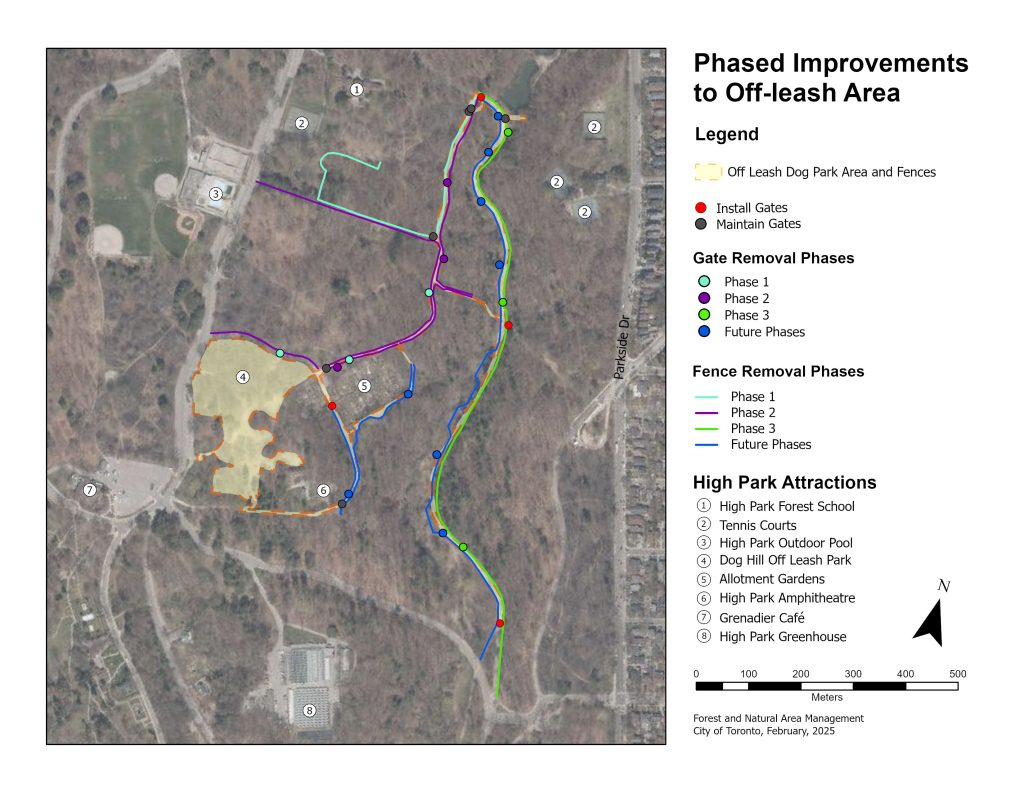
The High Park Off-Leash Area (OLA) is 8.5 acres of open area and designated trails, both natural and paved, under the canopy of mature trees. It is next to Environmentally Significant Areas, including rare Black Oak Savannah, which are sensitive to recreational impacts and degradation.
Existing fencing does not meet current specifications for OLA fencing. Dogs and people are able to scale the low fences and access sensitive natural areas through several gates in the OLA, resulting in informal trails that exacerbate erosion and the loss of rare vegetation. Difficulty navigating the OLA sometimes leads to unleashed dogs leaving the OLA and entering unfenced on-leash areas of the park, creating public safety concerns.
To address these issues, the OLA improvement plan will add and improve fencing, remove and install gates, and improve signage. Following the OLA infrastructure upgrades, ecosystem restoration will help protect rare black oak savannah and oak deciduous ecosystems.
The project will be carried out in phases. Phase 1 was completed in 2024, and Phase 2 will be completed in summer/fall 2025. Phase 3 is upcoming in 2026. With each phase, restoration efforts will coincide, which will include invasive species management, planting and prescribed burns in savannah sites.
While we aim to provide fully accessible content, there is no text alternative available for some of the content on this site. If you require alternate formats or need assistance understanding our maps, drawings, or any other content, please contact Karen Sun at 416-392-1891.

May 2025: After removing woody invasive species, nearly 900 native trees and shrubs were planted in the fenced natural area. This site was previously damaged by off-leash dogs and unofficial trails. Fencing now helps reduce erosion and supports native plants.
June 2025: Removal of herbaceous invasive species began in areas restored during Phase 1 and Phase 2. Volunteers from High Park Stewards and High Park Nature Centre manually removed species like Garlic Mustard (Alliaria petiolate). Urban Forestry staff used pesticides to treat Dog Strangling Vine (Vincetoxicum rossicum).
August 2025: Installation of post-and-paddle fencing began. Construction should finish by December 2025. Temporary trail closures may occur for safety. Please stay out of closed areas.
October 2025: About 700 native trees and shrubs were planted in a newly fenced natural area. This site was previously damaged by off-leash dogs and unofficial trails. Fencing will help reduce erosion and support native plants.
Also in October, removal of large invasive trees started in fenced areas. Species include Norway Maple (Acer platanoides), Linden (Tilia cordata), Manitoba Maple (Acer negundo), White Mulberry (Morus alba) and Black Locust (Robinia pseudoacacia). After removal, native trees and shrubs will be planted in Fall 2026. Large invasive tree removal helps restore ecosystems by reducing invasive species seed sources, and creating canopy gaps to promote new native tree and shrub plantings. Urban Forestry contractors are doing this work. Temporary trail closures may occur. Please avoid closed areas.
Late October/November 2025: Licensed Urban Forestry contractors will treat understory invasive species with pesticides. Watch for posted warning signs and avoid treatment areas. For more details, visit Urban Forest Management.
This project aims to reduce the impact of the Off-Leash Area (OLA) on nearby rare oak savannah habitat. Work includes invasive species management and long-term extensive restoration plantings. In some degraded savannah sites, prescribed burns may also be considered.
Community involvement is key. The High Park Nature Centre, High Park Stewards and other interested community groups will help support these restoration efforts.
Please email nrm@toronto.ca for upcoming restoration events.